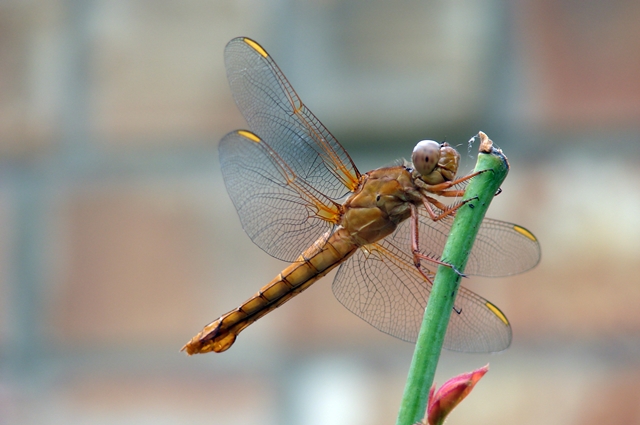2 July 2018. Researchers in Australia from academic, not-for-profit, and business labs are investigating a solution for infections that form on orthopedic implants, based on the structure of a dragonfly’s wing. The 4-year, AU$ 20 million (US$ 18.7 million) project involves a team from University of Adelaide, University of South Australia, the Innovative Manufacturing Cooperative Research Centre, and the Australian company Global Orthopaedic Technology.
The researchers are tackling a problem of infections that occur on replacement knees, hips, and other orthopedic implants after surgery. The initiative’s partners cite experts who say infections after surgery occur in 2 to 3 percent of implants, and cost some $1 billion worldwide. This infection rate has largely remained unchanged in 15 years, and often results in more surgery, longer recovery times, and additional trauma for patients.
The team plans to design a solution inspired by properties of wings on dragonflies. The dragonfly’s wing has tiny, nanoscale spikes called nanopillars that kill bacteria, thus protecting the dragonfly against infections. According to a study published last year, the nanopillars first trap bacteria, such as E. coli, onto the wing surface, followed by the shear force of the microbe trying to escape that rips into its bacterial cell membrane.
The Adelaide and South Australia labs expect to incorporate that concept into experimental titanium orthopedic implants. The researchers will test the nanotech implants for safety and bacterial-killing properties. “This research is a combination of cell biology and very clever nanomanufacturing techniques, driven by an unmet medical need,” says Gerald Atkins, scientific director of Adelaide’s Centre for Orthopaedic and Trauma Research, in a joint statement. South Australia engineering professor Krasi Vasilev adds that the project is also “a great example of transdisciplinary collaboration between scientists, clinicians, and industry, transforming health care, manufacturing industry and the Australian economy.”
Global Orthopaedic Technology, a developer of orthopedic implants, is providing commercialization expertise to take the technology to market, and is committing $3 million to the project, as well as in-kind contributions. Innovative Manufacturing Cooperative Research Centre, or IMCRC, a not-for-profit organization that conducts research and development of manufacturing processes, is also contributing $3 million to the project.
IMCRC’s managing director and CEO David Chuter says the project has implications beyond medical devices to other industries dealing with the presence of bacteria. “Due to the nature of the nano surface, which is independent of the chemistry and material properties of the substrate to which it is applied,” notes Chuter, “the technology can potentially be used in other manufacturing processes across multiple industries, most notably the hospital supplies and equipment industry, the food industry, the marine industry, the building products industry, and the aeronautical industry.”
South Australia’s Vasilev tells more about the project in the following video.
- Nanoscale Cell-Like Robots Shown to Clean Blood
- Bio-Inspired Surgical Camera Highlights Cancer Tissue
- Patent Awarded for Nanoparticle Drug, Cannabis Delivery
- Quick Bacterial Blood Detection Gains Breakthrough Tag
- Lab Burns Graphene Circuits into Food, Fabrics
* * *


 RSS - Posts
RSS - Posts
You must be logged in to post a comment.